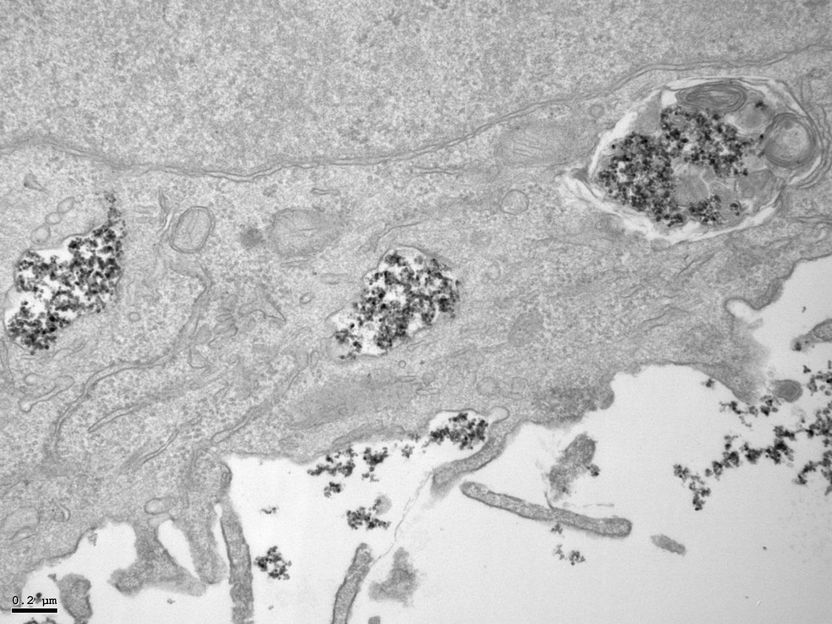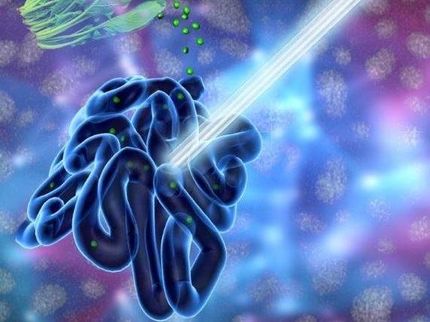Magnetic metal nanoparticles for targeted drug delivery and tumor treatment
Nanoparticle coating as the main factor determining how nanoparticles move and degrade within the cell.
Magnetic metal nanoparticles have been applied in therapy and diagnostics with promising results. These iron oxide nanoparticles are useful for introducing them into cells and performing various functions, such as localized drug release, eliminating tumor cells by emitting heat (hyperthermia) or for diagnostics in magnetic resonance imaging. But to obtain clinical approval, it is necessary to know how they behave inside cells, what intracellular pathways they activate, and how they are degraded, in order to determine their therapeutic effects and possible toxicity.

Iron oxide nanoparticles inside cell vesicles in an image taken with a transmission electron microscope (TEM).
Yadileiny Portilla/Domingo F Barber, CNB-CSIC
Now, a study led by CSIC researchers and published in Biomaterials has shown that the coverage of these nanoparticles is key to understanding how they move and how they degrade inside cells. For use in medical applications, they are usually coated with different types of molecules and polymers (macromolecules) to make them more biocompatible, stable, biodegradable and to prevent them from forming aggregates that could generate thrombi. This work shows that this coating is decisive in improving the effectiveness of nanoparticles.
The researcher Domingo F. Barber, from the National Center for Biotechnology (CNB-CSIC), who led the study, points out: "Depending on the type of coating used, when the nanoparticles come into contact with the biological environment, different interactions occur with the proteins in the environment, affecting their final size, the cellular uptake pathway, as well as the transit they follow until their degradation in the cellular machinery in charge of this process (the endolysosomes: a body in the cell cytoplasm that is essential for eliminating pathogens or microorganisms)".
Yadileiny Portilla, researcher at the CNB-CSIC and first author of the work together with Vladimir Mulens and also working with researcher Puerto Morales, from the Institute of Materials Science of Madrid (ICMM-CSIC), emphasizes: "The type of coating and the increase in size of the nanoparticle due to its association with proteins of the biological medium are essential in dictating the routes of cell entry and intravesicular transit, as well as in the speed of cell degradation".
In tumor cells," adds Portilla, "nanoparticles accumulate in endolysosomes, where they are degraded more slowly, while in macrophage cells in the tumor environment, degradation occurs more or less rapidly depending on the coating, since, depending on the coating, they accumulate in vesicles with different degradation capacity. These findings are of vital importance when designing nanoparticles, since we can, depending on their future application, enhance the desired effect depending on the therapeutic target".
The use of iron oxide nanoparticles is widespread in several fields of biomedicine, as they could facilitate the targeted release of drugs and biomolecules, their ability to produce heat is used in the treatment of cancer by intracellular hyperthermia, and they are also capable of generating contrast in diagnostic magnetic resonance imaging.
Note: This article has been translated using a computer system without human intervention. LUMITOS offers these automatic translations to present a wider range of current news. Since this article has been translated with automatic translation, it is possible that it contains errors in vocabulary, syntax or grammar. The original article in Spanish can be found here.
Original publication
Other news from the department science
These products might interest you
Most read news
More news from our other portals
See the theme worlds for related content
Topic world Diagnostics
Diagnostics is at the heart of modern medicine and forms a crucial interface between research and patient care in the biotech and pharmaceutical industries. It not only enables early detection and monitoring of disease, but also plays a central role in individualized medicine by enabling targeted therapies based on an individual's genetic and molecular signature.

Topic world Diagnostics
Diagnostics is at the heart of modern medicine and forms a crucial interface between research and patient care in the biotech and pharmaceutical industries. It not only enables early detection and monitoring of disease, but also plays a central role in individualized medicine by enabling targeted therapies based on an individual's genetic and molecular signature.




















































